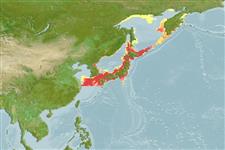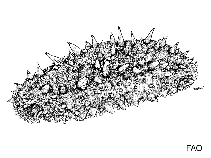Apostichopus japonicus (Selenka, 1867)
Japanese sea cucumber| Native range | All suitable habitat | Point map | Year 2050 |

|
| This map was computer-generated and has not yet been reviewed. |
| Apostichopus japonicus AquaMaps Data sources: GBIF OBIS |
رده بندی / Names اسامي عام | مترادف | CoL | ITIS | WoRMS
Holothuroidea | Synallactida | Stichopodidae
Environment: milieu / climate zone / تغييرات عمق / distribution range بوم شناسي
; تغييرات عمق 0 - 200 m (مرجع 635), usually 50 - 100 m (مرجع 635). Subtropical; ? - 30°C (مرجع 77134), preferred 16°C (مرجع 107945); 63°N - 31°N, 117°E - 165°E (مرجع 112755)
Distribution كشورها | مناطق سازمان خوار و بار جهاني (FAO) | Ecosystems | ظهور | معرفي
Northwest Pacific: Japan (from Hokkaido to Kyushu), China, Korean Peninsula and Far Eastern Russia (Karaginskogo Island).
Length at first maturity / Size / Weight / سن
بلوغ: Lm ?, range 20 - ? cm Max length : 30.0 cm TL جنس نر / بدون خواص جنسي; (مرجع 101467)
Life cycle and mating behavior بلوغ | تولید مثل | تخم ریزی | Eggs | Fecundity | Larvae
مآخذ اصلی
مراجع | هماهنگ كننده | همكاران
Kan-no, M. and A. Kijima 2003 Genetic differentiation among three color variants of Japanese sea cucumber Stichopus jamponicus. Fisheries Science 69:806-812. (مرجع 77132)
وضعيت در فهرست قرمز IUCN
(مرجع 130435: Version 2025-1)
وضعيت از نظر سايتس (مرجع 108899)
CMS (مرجع 116361)
خطر برای انسان ها
استفاده انسانی
ماهي گيري – شيلات: تجاري; آبزي پروري: تجاري
FAO - آبزي پروري: production, نمايه گونه; ماهي گيري – شيلات: landings | FishSource | Sea Around Us
ابزارها
اطلاعات بيشتر
منابع اينترنتي
BHL | BOLD Systems | CISTI | DiscoverLife | FAO(آبزي پروري: نمايه گونه; ماهي گيري – شيلات: ; publication : search) | Fishipedia | GenBank (ژنوم, نوکلئوتيد) | GloBI | Gomexsi | Google Books | Google Scholar | Google | PubMed | Tree of Life | Wikipedia (برو, جستجو) | Zoological Record



